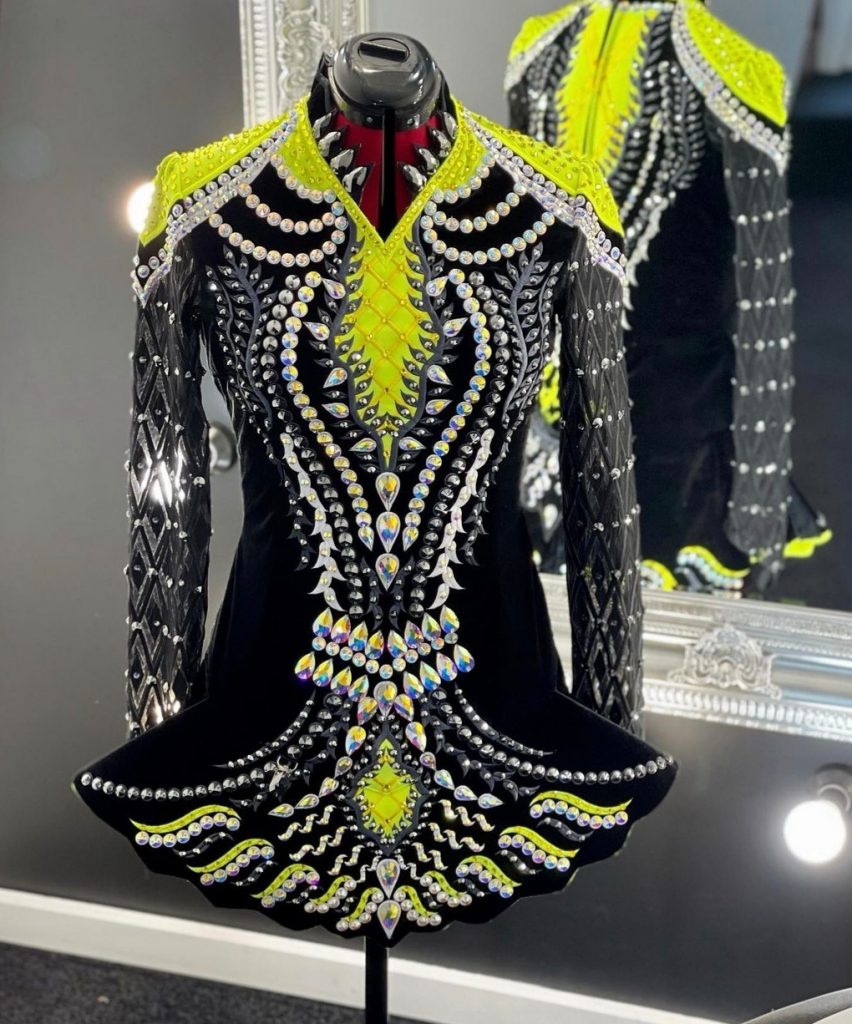
Costume design by Prodigy Downunder featuring Zahira crystals
The History of Irish Dancing
The very early roots of Irish dancing can be traced back to the ancient Celts that lived in Ireland before the introduction of Christianity and other external influences. Celtic communities held large celebrations called ‘feis’ (the modern word would be ‘festival’) with displays of art, music and culture including dancing, though the dances were most commonly performed in circular formations instead of lines. Modern Irish dance competitions are still referred to as a feis (pronounced fesh)!
After the Normans invaded Ireland in the 12th century, they brought along their culture and shut out the Irish culture, forcing it underground. One element of the Norman customs was a dance called the ‘Carol’, which was the first historically recorded style of Irish dancing.
A ‘Carol’ involved a singer being placed at the centre of a circle of dancers who would dance along according to the song being sung. By around the 1500’s this had evolved into three types of Irish dance: the “Rinnce Fada” (or Long Dance), the Irish Hey and the Trenchmore. By this time, the popular formations had started to switch from circular to the line forms that are seen in today’s Irish dancing.
In the 18th Century teachers of peasants and commoners emerged in Ireland known as “the Dancing Master”. It was around this time that Irish dancing took on the form that is recognised today. The Dancing Master would teach groups of people in line formations as an easy way to reach a larger group of people. The most talented would be given special sections of music in a performance to dance ‘solo’ and display their skills.
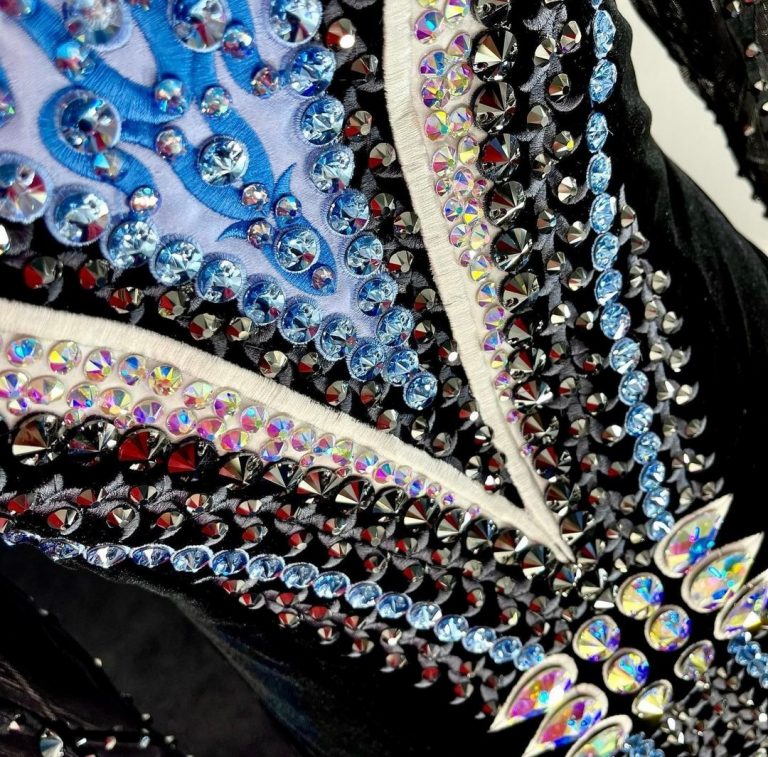
Costume design by Prodigy Downunder featuring Zahira crystals
Irish Dancing Today
Irish dancing continued to grow and evolve over the next three centuries. In 1893 the Gaelic League was formed to promote Irish culture which had been suppressed over the centuries. And in 1929 the Irish Dancing Commission was formed and continues to this day; the commission oversees the competitions, rules and teaching of Irish dancing.Today, Irish dancing can be broken into a few different categories of dance.
The most frequently seen and practiced type of Irish dancing is Stepdancing. Stepdancing is recognised by the stiff upper body combined with quick, precise, rhythmic movements of the feet. All Irish dancing can also be categorised as either soft-shoe or hard-shoe. Soft-shoe dances include single jigs, light jigs, slips and reels. Hard-shoe dances include hornpipes, treble jigs, and the treble reel.
You might think that Irish dancing looks somewhat like Irish tap dance or even ballet; that’s because modern Irish dance has drawn on these styles to grow into its current, unmistakeable form!
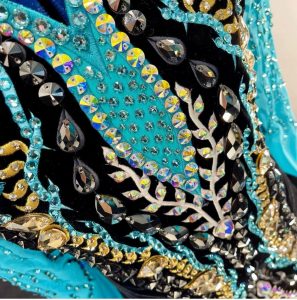
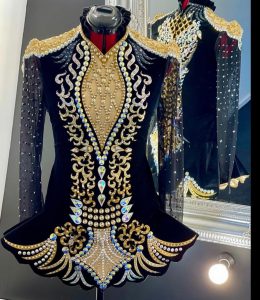
Costume design by Prodigy Downunder featuring Zahira crystals
Irish Dancing Music
Like Irish dancing itself, the music that accompanies it is diverse and complex. There are many types of Irish dance music written in many different time signatures, and each of these are will invite a different style of dance, but there is no formal association between types of music and types of dance. Some types of Irish dance music have even branched away from accompanying dance and are meant to be attentively listened to for appreciation.
The most common music in Irish dancing is called a Reel in standard 4/4 timing. But there is also the hornpipe in accented 4/4 time, the jig in 6/8 timing, slip-jigs & hop-jigs in 9/8 timing, slides in 12/8 timing and polkas in 2/4 timing. There are many thousands of individual pieces of Irish dancing music that are intended to inspire listeners to get to their feet and dance! Irish dancing music is based on a rather simple form, but has in recent years branched into more sophisticated complexity. A dance tune will normally consist of two eight-bar phrases called ‘Parts’ that are followed by a complementary phrase called a ‘turn’. This will then be repeated several times. It sounds like it could be a recipe for boredom, but a player worth his salt will introduce variation into each phrase so that no two repetitions are alike in one play-through.
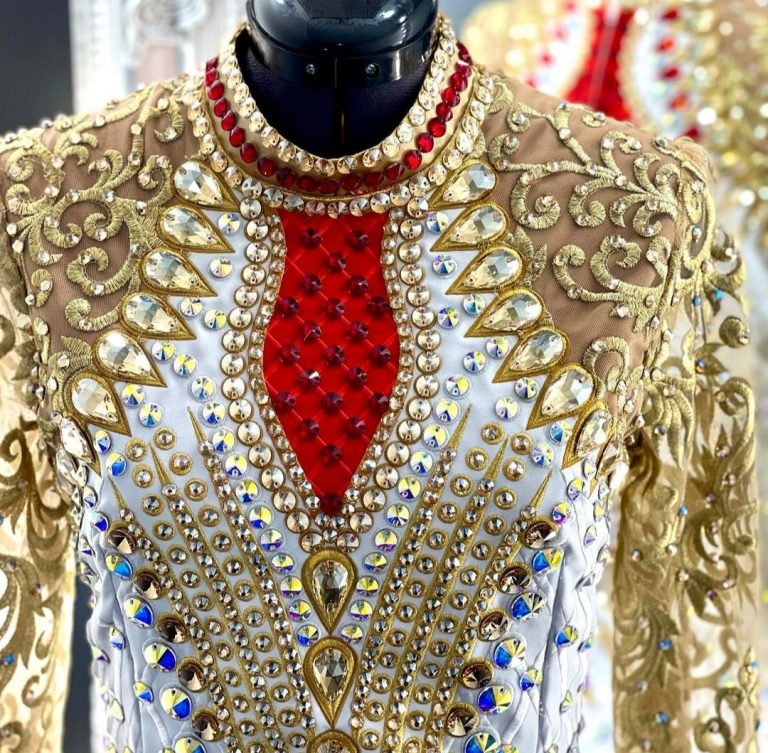
Costume design by Prodigy Downunder featuring Zahira crystals
Irish Dancing Costume
Irish dancing costumes can vary quite dramatically, depending on the type of performance you’re watching and where you’re watching it. Traditional Irish dance dress is typically quite modest. Generations ago, and today in social settings, dancers would generally wear their “Sunday best”, meaning the clothes that a person would wear to church. But this has changed since the 1970’s and 1980’s.
In recent decades it has become increasingly common in competitions and public performances, particularly with female dancers, to wear ornately embroidered and embellished dresses. These dresses are still based on traditional peasant wear but are embroidered with intricate Celtic designs and are often embellished with shining rhinestones and gemstones (just like the ones we have on offer!), trims and sequins.
Since the introduction of Riverdance to the world, it has become increasingly common for Irish dancers’ dresses to glisten with high quality decorations to accompany the embroidery, the type of which you can find right here!
Male Irish dancers have a more reserved style of dress; wearing a dress-shirt, vest & tie with black trousers.
Irish dancing wigs are also commonly used now, instead of curling the hair to achieve the tight and bouncy curls seen on Irish dancers. It has also become commonplace for girls to wear a bun or hairpiece.
Today, Irish dancing shoes, the hard ones that is, are made from leather with fibreglass or resin heels and tips in order to produce the percussive sound. Entirely soft Irish dancing shoes are only worn by girls and are called Ghillies; male soft-shoe dancing features a hard heel that you can hear clicking during the performance.
If you and your team are searching for a way to make your Irish dance dress stand out in a competition or a public performance, get in contact with us! We have a background in competitive dance and understand how to co-ordinate the right rhinestones, gemstones and decorations to reach the effect on you or your teams’ dresses that you need!
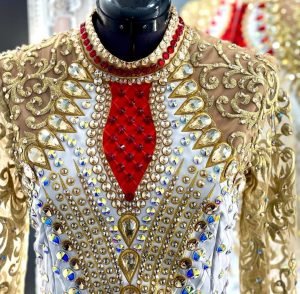
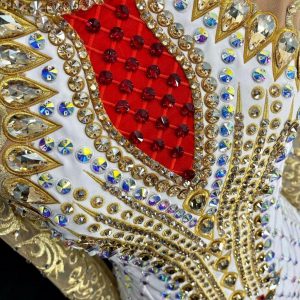
Costume design by Prodigy Downunder featuring Zahira crystals

